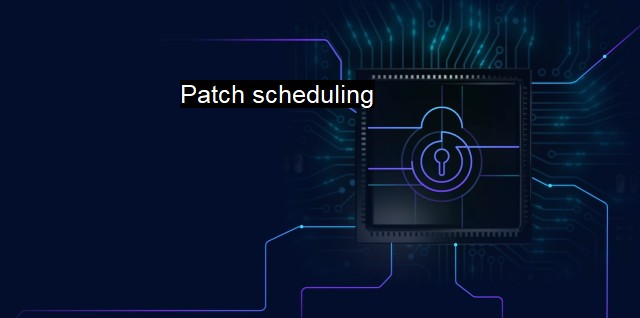What is Patch scheduling?
Why Regular Patch Scheduling is Essential for Robust Cybersecurity Defense and Mitigation
Patch scheduling is a systematic process used to update, fix, or improve a software system, primarily intended to cover vulnerabilities and provide protection against potential threats or attacks. Most organizations have software systems that they use to run their operations effectively. For such systems to function at optimum levels, they need to be regularly updated, and the vulnerabilities possibly present in them need to be detected and fixed.Patch scheduling falls under the broader system of patch management. This is a systematic approach used to handle updates and changes in a software system, inclusive of acquisition, testing, installing and maintaining these upgrades, all in a structured and methodically managed manner. Many organizations use patch management software to simplify the patch scheduling process significantly, assisting with administering patches to large systems with various hardware configurations and software prerequisites.
Appropriately scheduled patches ensure vulnerabilities and possible attack surfaces in existing infrastructure do not have the effortlessness to fall into misuse before correction or removal. Prompt application of the patches reduces the time between the vulnerability discovery and its shortcomings being addressed, therefore decreasing the potential risk of exploitation. If cybersecurity patches are delayed or irregular, then the infrastructure in question's window of exposure to the potential hazards increases, thus making it a ripe target for malicious entities.
Patches are rolled out regularly to tackle new vulnerabilities that hackers can exploit, but patch scheduling accomplishes more than just remedying vulnerabilities. Other patches can enhance the software, adjust user interfaces, buttress firewalls, and tweak antivirus capacities. New features can often be introduced or updated through patches, optimizing efficiency, utility, and security for users. Therefore, overlooking patch scheduling can lead to software functioning at less than their optimum capability, thereby also detrimentally impacting productivity.
Patch scheduling is not merely about continuously updating the software. It’s important to acknowledge that every patch has potential consequences, and integrating a patch into an existing system could potentially disrupt other elements of the software. Thus, patch scheduling necessitates a strategic and calculated approach. Updates need to be allocated to a non-production environment first for the duration of testing. If it functions without causing issues, this fresh version of the code can then be progressed to production applications safely. This aids in ensuring that the reliability and uptime of operations aren't jeopardized and business continuity remains intact.
Versions and pointers are usually distributed by software developers for downloaded patches, indicating what the patch performs. They can highlight new features that augment software operation to deliver advanced performance. Software owners often benefit from maintaining regular communication with the software providers, as doing so ensures that the business can react quickly when a vulnerability or malfunction occurs in the software.
Adequate patch scheduling takes into account the rate of roll-out, the priority of systems to be patched, and the potential disruption caused by the patching activity. It’s a balance of mitigating exposure to vulnerability, improving system efficiency and performance, and the necessity for stable operations without interruptions.
The crux of patch scheduling lies in the considered management of frequent software updates to better facilitate optimal program functioning. Operating in tandem with robust cybersecurity and antivirus protocols, this heightens the overall security against potential risks, threats, and cyber-attacks. This makes it an important and essential process to ensure efficient, effective and safe digital operations – be it a small retail business, a multi-national corporation, or even personal home computer systems.

Patch scheduling FAQs
What is patch scheduling?
Patch scheduling is the process of organizing and planning the deployment of software patches, updates, and fixes for applications and systems. It involves determining a suitable time and frequency for the installation of patches, to minimize the risk of security vulnerabilities and system downtime.Why is patch scheduling important in cybersecurity?
Patch scheduling is crucial in cybersecurity because software vulnerabilities are frequently exploited by cybercriminals to gain unauthorized access or execute malicious code. By scheduling regular patch updates, organizations can ensure that any known vulnerabilities are addressed in a timely way, reducing the risk of exploitation and data breaches.How often should patch scheduling be done?
The frequency of patch scheduling depends on the risk level and criticality of the systems and applications. Generally, it is recommended to schedule patch updates at least once a month, with emergency out-of-band updates as needed. However, some applications may require more frequent updates, while others can be updated less frequently.What are some best practices for effective patch scheduling?
Some best practices for effective patch scheduling include: prioritizing patches based on risk and criticality, testing patches in a development environment before deploying to production systems, backing up critical data before patching, communicating patch schedules to stakeholders, and using automated patch management tools to streamline the process.| | A | | | B | | | C | | | D | | | E | | | F | | | G | | | H | | | I | | | J | | | K | | | L | | | M | |
| | N | | | O | | | P | | | Q | | | R | | | S | | | T | | | U | | | V | | | W | | | X | | | Y | | | Z | |
| | 1 | | | 2 | | | 3 | | | 4 | | | 7 | | | 8 | | |||||||